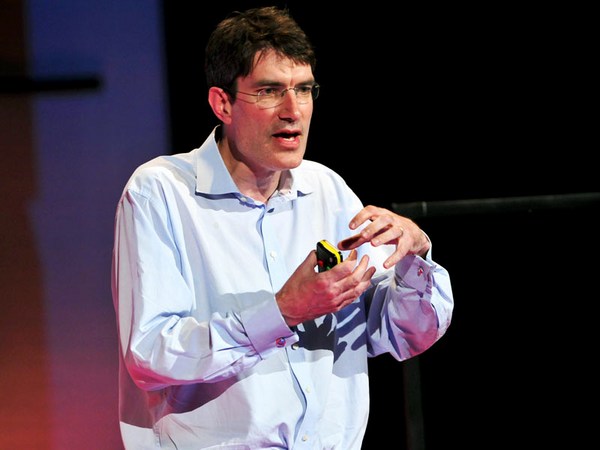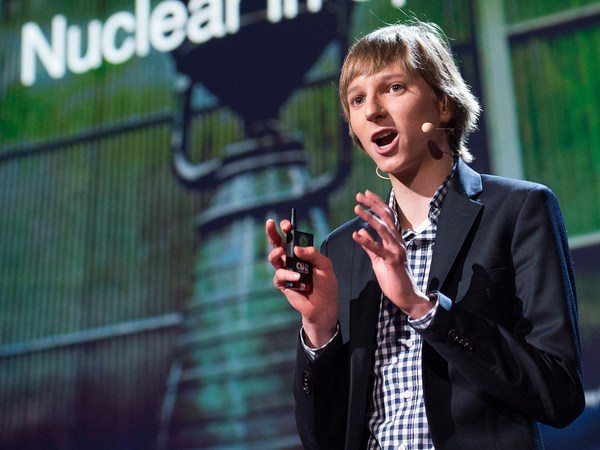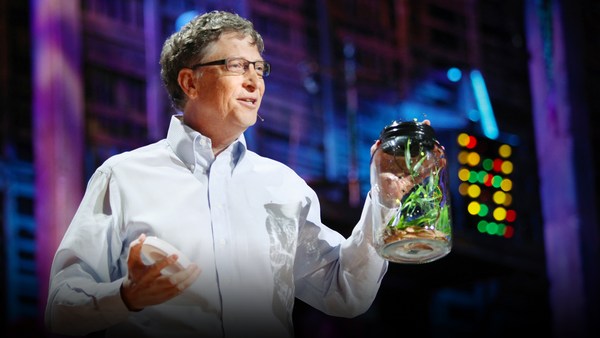Nearly everyone in the world is part of some community, whether large or small. And all of these communities have similar needs. They need light, they need heat they need air-conditioning. People can't function very well when it's too hot or too cold. They need food to be grown or provided, distributed and stored safely. They need waste products to be collected, removed and processed. People in the community need to be able to get from one place to another as quickly as possible. And a supply of energy is the basis for all of these activities. Energy in the form of electricity provides light and air-conditioning. Energy in the form of heat keeps us warm. And energy in chemical form provides fertilizer; it drives farm machinery and transportation energy.
Now, I spent 10 years working at NASA. In the beginning of my time there in 2000, I was very interested in communities. But this is the kind of community I was thinking of -- a lunar community It had all of the same needs as a community on Earth would have, but it had some very unique constraints. And we had to think about how we would provide energy for this very unique community. There’s no coal on the Moon. There's no petroleum. There’s no natural gas. There's no atmosphere. There’s no wind, either. And solar power had a real problem: the Moon orbits the Earth once a month. For two weeks, the sun goes down, and your solar panels don't make any energy. If you want to try to store enough energy in batteries for two weeks, it just simply isn't practical. So nuclear energy was really the only choice.
Now, back in 2000, I didn't really know too much about nuclear power, so I started trying to learn. Almost all of the nuclear power we use on Earth today uses water as a basic coolant. This has some advantages, but it has a lot of disadvantages. If you want to generate electricity, you have to get the water a lot hotter than you normally can. At normal pressures, water will boil at 100 degrees Celsius. This isn't nearly hot enough to generate electricity effectively. So water-cooled reactors have to run at much higher pressures than atmospheric pressure. Some water-cooled reactors run at over 70 atmospheres of pressure, and others have to run at as much as 150 atmospheres of pressure. There's no getting around this; it's simply what you have to do if you want to generate electricity using a water-cooled reactor. This means you have to build a water-cooled reactor as a pressure vessel, with steel walls over 20 centimeters thick. If that sounds heavy, that's because it is.
Things get a lot worse if you have an accident where you lose pressure inside the reactor. If you have liquid water at 300 degrees Celsius and suddenly you depressurize it, it doesn't stay liquid for very long; it flashes into steam. So water-cooled reactors are built inside of big, thick concrete buildings called containment buildings, which are meant to hold all of the steam that would come out of the reactor if you had an accident where you lost pressure. Steam takes up about 1,000 times more volume than liquid water, so the containment building ends up being very large, relative to the size of the reactor.
Another bad thing happens if you lose pressure and your water flashes to steam. If you don't get emergency coolant to the fuel in the reactor, it can overheat and melt. The reactors we have today use uranium oxide as a fuel. It's a ceramic material similar in performance to the ceramics we use to make coffee cups or cookware or the bricks we use to line fireplaces. They're chemically stable, but they're not very good at transferring heat. If you lose pressure, you lose your water, and soon your fuel will melt down and release the radioactive fission products within it.
Making solid nuclear fuel is a complicated and expensive process. And we extract less than one percent of the energy for the nuclear fuel before it can no longer remain in the reactor. Water-cooled reactors have another additional challenge: they need to be near large bodies of water, where the steam they generate can be cooled and condensed. Otherwise, they can't generate electrical power. Now, there's no lakes or rivers on the Moon, so if all of this makes it sound like water-cooled reactors aren't such a good fit for a lunar community, I would tend to agree with you.
(Laughter)
I had the good fortune to learn about a different form of nuclear power that doesn't have all these problems, for a very simple reason: it's not based on water-cooling, and it doesn't use solid fuel. Surprisingly, it's based on salt.
One day, I was at a friend's office at work, and I noticed this book on the shelf, "Fluid Fuel Reactors." I was interested and asked him if I could borrow it. Inside that book, I learned about research in the United States back in the 1950s, into a kind of reactor that wasn't based on solid fuel or on water-cooling. It didn't have the problems of the water-cooled reactor, and the reason why was pretty neat. It used a mixture of fluoride salts as a nuclear fuel, specifically, the fluorides of lithium, beryllium, uranium and thorium. Fluoride salts are remarkably chemically stable. They do not react with air and water. You have to heat them up to about 400 degrees Celsius to get them to melt. But that's actually perfect for trying to generate power in a nuclear reactor.
Here's the real magic: they don't have to operate at high pressure. And that makes the biggest difference of all. This means they don't have to be in heavy, thick steel pressure vessels, they don't have to use water for coolant and there's nothing in the reactor that's going to make a big change in density, like water. So the containment building around the reactor can be much smaller and close-fitting. Unlike the solid fuels that can melt down if you stop cooling them, these liquid fluoride fuels are already melted, at a much, much lower temperature. In normal operation, you have a little plug here at the bottom of the reactor vessel. This plug is made out of a piece of frozen salt that you've kept frozen by blowing cool gas over the outside of the pipe. If there's an emergency and you lose all the power to your nuclear power plant, the little blower stops blowing, the frozen plug of salt melts, and the liquid fluoride fuel inside the reactor drains out of the vessel, through the line and into another vessel called a drain tank. Inside the drain tank, it's all configured to maximize the transfer of heat, so as to keep the salt passively cooled as its heat load drops over time. In water-cooled reactors, you generally have to provide power to the plant to keep the water circulating and to prevent a meltdown, as we saw in Japan. But in this reactor, if you lose the power to the reactor, it shuts itself down all by itself, without human intervention, and puts itself in a safe and controlled configuration.
Now, this was sounding pretty good to me, and I was excited about the potential of using a liquid fluoride reactor to power a lunar community. But then I learned about thorium, and the story got even better. Thorium is a naturally occurring nuclear fuel that is four times more common in the Earth's crust than uranium. It can be used in liquid fluoride thorium reactors to produce electrical energy, heat and other valuable products. It's so energy-dense that you could hold a lifetime supply of thorium energy in the palm of your hand. Thorium is also common on the Moon and easy to find. Here's an actual map of where the lunar thorium is located. Thorium has an electromagnetic signature that makes it easy to find, even from a spacecraft.
With the energy generated from a liquid fluoride thorium reactor, we could recycle all of the air, water and waste products within the lunar community. In fact, doing so would be an absolute requirement for success. We could grow the crops needed to feed the members of the community even during the two-week lunar night, using light and power from the reactor. It seemed like the liquid fluoride thorium reactor, or LFTR, could be the power source that could make a self-sustainable lunar colony a reality.
But I had a simple question: If it was such a great thing for a community on the Moon, why not a community on the Earth, a community of the future, self-sustaining and energy-independent? The same energy generation and recycling techniques that could have a powerful impact on surviving on the Moon could also have a powerful impact on surviving on the Earth. Right now, we're burning fossil fuels because they're easy to find and because we can. Unfortunately, they're making some parts of our planet look like the Moon. Using fossil fuels entangles us in conflict in unstable regions of the world and costs money and lives.
Things could be very different if we were using thorium. You see, in a LFTR, we could use thorium about 200 times more efficiently than we're using uranium now. And because the LFTR is capable of almost completely releasing the energy in thorium, this reduces the waste generated over uranium by factors of hundreds, and by factors of millions over fossil fuels. We're still going to need liquid fuels for vehicles and machinery, but we could generate these liquid fuels from the carbon dioxide in the atmosphere and from water, much like nature does. We could generate hydrogen by splitting water and combining it with carbon harvested from CO2 in the atmosphere, making fuels like methanol, ammonia, and dimethyl ether, which could be a direct replacement for diesel fuels. Imagine carbon-neutral gasoline and diesel, sustainable and self-produced.
Do we have enough thorium? Yes, we do. In fact, in the United States, we have over 3,200 metric tons of thorium that was stockpiled 50 years ago and is currently buried in a shallow trench in Nevada. This thorium, if used in LFTRs, could produce almost as much energy as the United States uses in three years. And thorium is not a rare substance, either. There are many sites like this one in Idaho, where an area the size of a football field would produce enough thorium each year to power the entire world.
Using liquid fluoride thorium technology, we could move away from expensive and difficult aspects of current water-cooled, solid-fueled uranium nuclear power. We wouldn't need large, high-pressure nuclear reactors and big containment buildings that they go in. We wouldn't need large, low-efficiency steam turbines. We wouldn't need to have as many long-distance power transmission infrastructure, because thorium is a very portable energy source that can be located near to where it is needed. A liquid fluoride thorium reactor would be a compact facility, very energy-efficient and safe, that would produce the energy we need day and night, and without respect to weather conditions. In 2007, we used five billion tons of coal, 31 billion barrels of oil and five trillion cubic meters of natural gas, along with 65,000 tons of uranium to produce the world's energy. With thorium, we could do the same thing with 7,000 tons of thorium that could be mined at a single site.
If all this sounds interesting to you, I invite you to visit our website, where a growing and enthusiastic online community of thorium advocates is working to tell the world about how we can realize a clean, safe and sustainable energy future, based on the energies of thorium.
Thank you very much. (Applause)





